Six Ute people of the Colorado Plateau
C.R. Savage of Salt Lake City
An albumen print portrait of six Ute, an indigenous people of the Great Basin and Colorado Plateau, an area which covers present-day south-east Utah, western Colorado and northern New Mexico. In the past their territory also included parts of Wyoming, Nevada and Arizona. The Ute dialect is a Colorado River Numic language, part of the Uto-Aztecan language family.
Historically the Utes belonged to almost a dozen nomadic bands, who came together for ceremonies and trade. They also traded with neighbouring tribes, including some of the Pueblo peoples.
Although they had limited contact with the Spanish in the 18th century, their first sustained contact with Euro-Americans began in 1847 with the arrival of the Mormons in the American West. The Ute people fought to protect their homelands but in 1864 Brigham Young persuaded Abraham Lincoln to forcibly remove the Utah Utes to a reservation. In 1881 the Colorado Utes were also forced onto a reservation.
Photographed by C.R. Savage of Salt Lake City.
Charles Roscoe Savage is perhaps best remember for his photographs of the coming together of the Union Pacific and the Central Pacific Railroads at Promontory Point in Utah in 1869. Born in Southampton in England in 1832, he emigrated to New York in 1855. Having converted to the Church of Jesus Christ of Latter-day Saints while still a youth in England, he and his family made their way to Salt Lake City, where Charles established a successful photographic studio. He died, aged 76, on 4 February 1909.
Condition: the print presents a small patch of foxing in the area of the background and an inscription recto on the print is showing through slightly in the pale area of the background. The tones of the print, however, are excellent. It is mounted on a slightly grubby album page which is very firm and solid, with crisp edges and sharp corners. An inked inscription verso in German identifies the sitters’ tribe. The number 2 has been inked in the lower right-hand corner of the print.
Dimensions: the print measures 7” by 4.9” (17.8 cm by 12.4 cm); the page on which it’s mounted measures 9.2” by 11.7” (24.5 cm by 29.6 cm).
code: cat004

